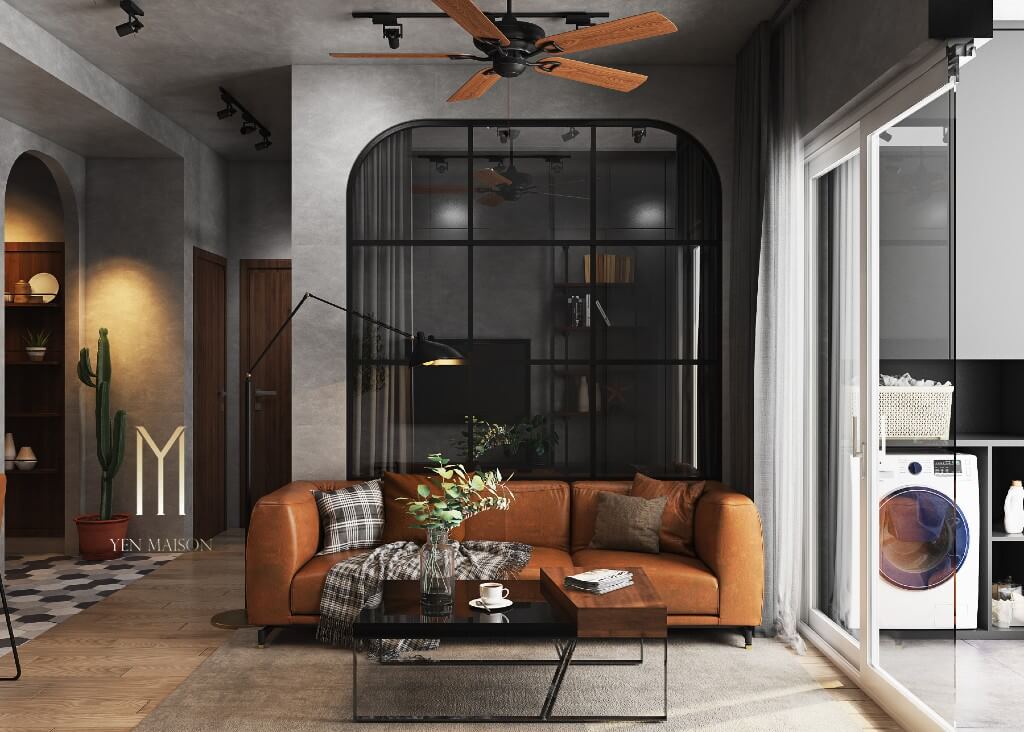
If you’re already blessed with a varied array of distinct furnishings and admire the idea of beautifully rendered juxtapositions, this may just be the perfect interior design styles living room to consider. Bring the beach into your house no matter how far you live from the shore with a coastal design style. This seaside aesthetic imitates a slow-paced lifestyle with its light colors and textures. Include shades of blue and white, natural textured fabrics like linen and cotton, and motifs of items you might find on the beach, like driftwood, seashells, and coral. A bit of patina is also encouraged; look for weathered wood, cerused surfaces, or chippy painted furniture. Elements contributing to contemporary style include open layouts, straight lines, glossy finishes, and plenty of breathing space with little ornamentation.
Vintage Style
That said, we’re all for modern interior design styles that combine various elements to create a beautifully realized, one-of-a-kind room. Some typical designs adopted by mid-century modern interior designers include simple fabrications, pared-down forms, molded plastic plywood, and natural-shaped furniture like an egg-shaped chair, for instance. Their styles and designs are often somewhere along the lines of ‘contemporary’ and are super versatile, which makes the transition simply flawless. The Traditional style of home décor has its roots in 18th and 19th century Europe and is based on conventional ideas from that time of how a room should look. Despite hailing from a specific time period, Traditional interiors seek to exhibit a timeless elegance that combines warm tones and cozy fabrics with classic choices of furniture and furnishings.
Waterleaf Interiors

Think bold color palettes, textures, and patterns brought together to create a rich mix with utility and focal points in mind. When you hear "Scandinavian style," your mind might go straight to the displays at IKEA, but this minimalistic aesthetic goes beyond white walls. To achieve this cozy Nordic look, play with natural light, warm woods, and muted colors.
Contemporary remains an interior design classic
"One of the trends I’m most excited about is a lime plaster wall finish," says Decorist designer Jessie Yoon of Casa Nolita. Read on to see the most important design styles to know, with their key characteristics and insights from designers we love. The jungalow style combines the eclectic vibes of boho with a healthy dose of vibrant colors, tribal and modern prints, and pops of chlorophyll. Maximize your space’s ample natural lighting by liberally peppering houseplants in every nook and cranny, and pull in quirky thrift store finds to create this green-infused freestyle aesthetic. Check out the work of Justina Blakeney, the godmother of jungalow style, for more inspiration. Bohemian style is a joyous, soul-filled mix of eclectic textures, colors and patterns, inspired by art from around the world and layered to create a sense of depth and coziness.
Check out this wide-ranging selection of décors, from Minimalist to Maximalist and everything in between. If Scandinavian style and Japanese wabi-sabi style had a baby, it’d be Japandi. The wabi-sabi element encourages embracing the beauty in imperfections, adding a bit of personality into a room that could otherwise seem cold and austere. The Foyr Community network not only helps interior designers offer more value to their clients but also find jobs in the industry. Community members also get a free personal Portfolio website to showcase their unique interior design style and projects.
Minimalism
Stars like Gwyneth Paltrow, Beyoncé, Demi Moore, and Joe Jonas, just to name a few. All of who share her passion for design and excitement for innovation. An artist at heart, Stephanie Hatten founded SH Interiors to create spaces designed with her clients’ tastes in mind. Raised in Louisiana’s rich culture, antiques are one of Stephanie’s passions. This love leads to the fabulous incorporation of one-of-a-kind pieces into her designs.
The most popular colors for contemporary design are neutrals and shades of black and white. Adding a pop of color to your decor can make the look feel more inviting. The philosophy of minimalist interior design can be encapsulated in the phrase “less is more.” This design approach aims to create a sense of simplicity and elegance through the use of minimal furniture and decor. It focuses on simplicity, functionality, and essential beauty, often utilizing a monochromatic or neutral color palette and avoiding clutter. It heavily relies on a white or off-white color palette, emphasizing organic and natural shapes and materials. It emphasizes incorporating natural light and using fabrics and other materials to create cozy, intimate spaces.
Little Crown Interiors
Perhaps something about the boho style of one bedroom calls to you, or something about a mid-century modern living room stands out—save both. For curtains, sofas, armchairs, and cushions, heavy brocade or velvet fabrics are suitable in muted colors such as burgundy, brown, or green. Eye-catching checkered or striped patterns are also welcome in classically furnished rooms and complete an elegant overall picture. When you think of Bauhaus-style furniture, the first things that probably come to mind are sundry armchairs made of tubular steel and black leather. Solid wood pieces are common elements when furnishing a country-style home.
Traditional color palettes feature subdued hues with deeper colors near the floor, transitioning to lighter tones upwards. Woods like mahogany, maple, cherry, and walnut lend a rich and polished ambiance to the space. Furniture is arranged symmetrically to follow the room’s axis, facilitating conversation and reinforcing formality. At the same time, decor often includes paired accessories and symmetrically placed artwork.
Look for retro pieces, especially classics like the Eames lounge chair (look for a replica to avoid spending mega $$$ for an original), to bring this style to your space. However, for a modern Bauhaus, don’t feel restricted to a neutral color palette of just black, white, and gray, but consider incorporating primary colors too. Even patterns are allowed when decorating, if they are composed of simple, geometric shapes.
High contrast color combinations were the popular choice for color schemes. Popular combinations are not only hot pink and green, but also black and white. In addition, over the top chandeliers paired with high gloss or mirrored furniture is also a common combination. While most minimalist interiors have a neutral color scheme, primary colors can also be used as an accent color. Because of the less is more philosophy you’ll find functional furniture is the most essential design element. For example, a coffee table that lifts up to reveal storage is one of the many creative solutions minimal interiors use.
There is also a distinctive presence of strong visual lines, be it straight or curved. Modern Farmhouse is an interior design style that offers a modern twist on its more rustic cousin. It does this through the use of a less cluttered, more minimal approach combined with a pared-back and neutral color palette.
Bohemian interior designers are known for their use of those interior pieces that seem to possess nomadic and ethnic vibes. They also love playing with vibrant colors and rich patterns that appear to be bold and loud. Minimal interior styles and designs consist of ultra-clean lines and streamlined furnishings that have nothing flamboyant or glitzy about them. They also pick on-air and neutral color palettes that provide a great sense of warmth and coolness to the eyes. This take on the interior style and design follows the “Bauhaus principles” that make use of fluid lines, all-white color palettes, wide plank flooring and a strong focus on object proportions.
9 Home Décor Trends on Their Way Out, According to Design Insiders - Martha Stewart
9 Home Décor Trends on Their Way Out, According to Design Insiders.
Posted: Mon, 06 Nov 2023 08:00:00 GMT [source]
It’s not about the bling or the flashy; it’s the muted elegance that speaks volumes. Imagine walking into a room and feeling an immediate sense of calm, but also being awed by its understated opulence. Eclectic design is a showcasing of contrasting elements including colors, furnishings and materials. It can easily be overdone to look terrible, but when done well, the contrasting aspects can be tied together to create a cohesive and attractive design. The industrial interiors are often described as ‘truly rustic and mature’ considering it thrives on the liberal use of wooden elements and exposed steel.







